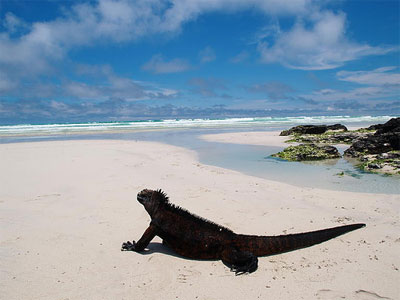With a surface area of 986 sqkm2, Santa Cruz is the second largest island of the Archipelago. Colonized since the 1920’s, Puerto Ayora, the populated part of the island, is the most important harbor of the Archipelago. With altitudes reaching 864 m. this island comprises of all plant zones, ranging from coastal to pampas. It is the home of the Charles Darwin Research Station and Galapagos National Park headquarters. Here you will learn first hand of the conservation and research efforts on the islands. See the tortoise hatchlings and breeding programs which are saving several races of tortoises from extinction. Tour the Van Straelen Exhibit Hall. Stroll through the town of Puerto Ayora to buy souvenirs, mail postcards and absorb some local color in the social heart of the islands. Tourism, boat repair, fishing and agriculture are the major trades.

The scenery of the highlands of Santa Cruz continually changes as we ascend through all seven different vegetation zones. When present (June to January) we are able to see the giant tortoises in the wild at a private farm. Visit a pair of large pit craters called “ Los Gemelos” (Spanish word for twins) and the largest lava tunnels found in Galapagos.
On this island we can see giant tortoises, vermillion flycatcher, large billed flycatcher, Darwin finches, pampa (fernsedge zone), scalesia trees, moconia.
Black Turtle Cove
We enter this tranquil lagoon surrounded by mangroves by dingy, paddling to remain as quiet as possible. From December to March, the Pacific green turtles come here to breed. Young white-tipped reef sharks, schools of spotted eagle rays and golden rays are often spotted. Three species of mangrove; red, white and black, are all found here.

Cerro Dragon
We enter this tranquil lagoon surrounded by mangroves by dingy, paddling to remain as quiet as possible. From December to March, the Pacific green turtles come here to breed. Young white-tipped reef sharks, schools of spotted eagle rays and golden rays are often spotted. Three species of mangrove; red, white and black, are all found here.
Bachas Beach
The sand at Las Bachas is made of decomposed coral, which makes it white and soft, and a favorite site for nesting sea turtles.
The Sally Lightfoot crabs are abundant on the lava rocks along the water's edge. These crabs will eat anything they can get their claws on.
On this hike, we saw flamingos, sally light-foot crabs, hermit crabs, black-necked stilts, and whimbrels.




Loves our bird guide Andrés and driver Edwin, Bothe Very good *****
Good Communication from start to finish. Got most of our target birds and some we did not expect. Good Show!